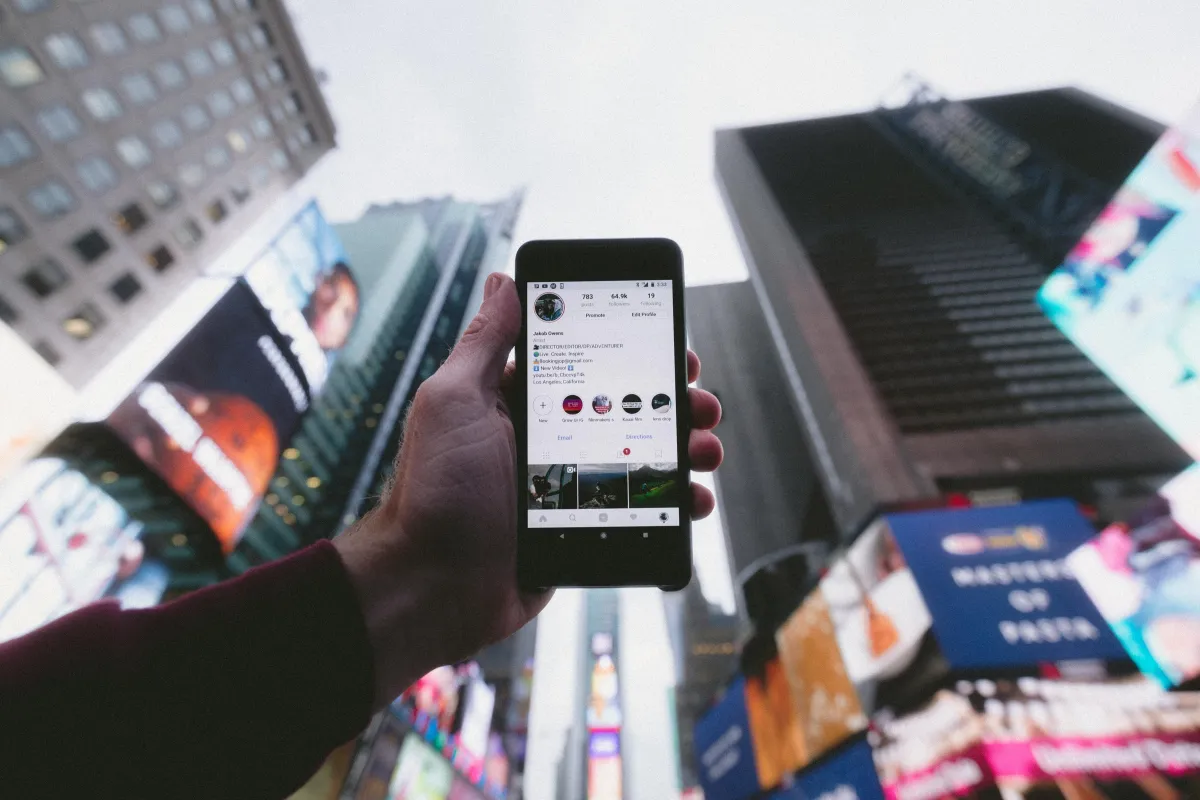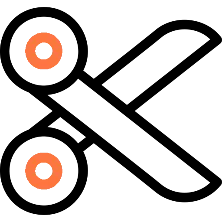
Short-form video: The Workhorse of Video Advertising
Short-form video: The Workhorse of Video Advertising
Video Content is all over the web nowadays.
Actually, it’s the thing that all customers want the most.
For your campaigns, it's essential to use every ad format accessible, even the largest. Video ads are presumably the most significant and frequently disregarded ad format.
Businesses struggle to divert viewers' attention from their inevitable scrolling as practically every platform tests short-form videos.
Your click-through rate, conversion rate, purchase intent, banner blindness, lead generation, and perhaps even brand awareness among your online viewers can all be improved by switching from static photos to video.
Time to accomplish your marketing objectives.

Video Advertising: What Is It?
Digital video advertising (both B2C and B2B video) promotes leveraging various online channels to reach your target audience with promotional short-form video content.
In a nutshell, it's when you embed video adverts inside web content.
Many people do, however, wonder how and why it operates.
Examining several options is one of the finest ways to find the answers to these issues.
Display ads, banner ads, classic advertisements, and more are some of the most popular ad formats.
Unfortunately, since displaying ads doesn't have the highest clickthrough rate, this advertising strategy has shown to be unproductive.
A person's attention span is currently extremely poor, which is another reason why marketers need to come up with innovative strategies to draw in and keep their audience.

Why Video Ads Are Important
One of the best things about web marketing is that you can use video incredibly well and reasonably cheaply.
In fact, if you are not already employing video marketing as part of your digital marketing strategy, then you are already behind.
Currently, 4 billion videos are seen on YouTube every single day by online users, and 92% of B2B buyers utilize online videos to inform their purchasing decisions.
And if these startling figures by themselves aren't enough to persuade you that video marketing must play a significant role in your marketing plan, here are eight other essential benefits.

Using Video Ads Can Boost Sales
But don't just believe what we say.
The addition of a video to a product description, according to two major online retailers, eBay and Amazon, can boost sales by up to 35%.
Anything from how-to guides to customer reviews can be featured in video advertisements.
The kind of product or service you are giving, as well as your target market, will all influence the type of video that is best for your business.
People LOVE To Share Videos
Whether or not they actually buy the product, viewers are more likely to share your video on social media if they think it is intriguing or entertaining.
In addition to increasing your SEO and attracting more customers to your product listing, it also makes people more aware of your brand or business.
Videos Are Mobile-Friendly
People who shop online on their mobile phones are becoming more and more common.
In reality, mobile phones overtook personal computers in 2016 as the device most frequently used for online transactions.
The fact that 88% of short videos are viewed on mobile devices is encouraging for companies who already employ video in their digital marketing campaigns.

Videos Are The Best Way To Educate Potential Customers
Video is a fantastic method to promote your products and services to your customers, especially if they are new or distinctive.
Offering your prospects short-form video content to clearly explain the product and its benefits is a terrific method to effectively convey your message, as opposed to lengthy explanations or even photographs that they may or may not take the time to check.
Videos Boost The SEO Ranking
Including videos on your website can help with search engine optimization if you want to raise its ranking.
The algorithms of search engines like Google and Bing now take video into account.
This implies that adding video to your website may help it rank higher in search results.
More Information In Less Time
Online shoppers want to get information quickly, and video makes that possible.
With video, you can say a lot more in a lot less time than you could with writing.
Additionally, since video enables you to employ both sight and sound, it improves your narrative skills and engages more senses.
To communicate the story of your business, describe in greater depth how your product or service may help your customers, or even publish testimonials, think about using video. There are so many possibilities.
All you have to do is figure out how to relate to your audience the most effectively.

Videos Can Fit In Any Budget Plan
Professional video production businesses can assist you in producing polished, useful videos, but if this is currently out of your price range, there are several apps and reasonably priced tools that can assist you in producing your own content using a basic camera or even your smartphone.
Additionally, it is free to launch a YouTube channel or broadcast a Facebook live video.
As your business expands, you'll probably want to invest in more expert video services, but one great thing about web video is that it's available to almost everyone.
Free Short-Form Video Content Analytics Tools Are Everywhere
You can check how well your short-form video content is performing using the built-in analytics tools on some of the most popular video-sharing websites, like Facebook and YouTube.
You can keep track of things like the number of views, likes, shares, and interactions with these tools.
Then, you can utilize this information to assist in the planning of upcoming marketing initiatives and even more successful short-form video content advertising.

The Effectiveness of video advertising
The best use of video advertisements is to promote your brand, website product, or service by raising awareness and encouraging consideration.
According to a survey done by Animoto, 93% of respondents said videos are useful when making a purchase.
The most popular type of content from brands on social media, according to consumers, is video.
When deciding where to place your digital marketing ads, you cannot overlook that percentage because it is quite large.
Consider yourself the consumer; as they go through their Facebook page, they are constantly being bombarded with visuals.
A well-made video will catch their attention, compel them to visit your landing page, and convert them into potential clients.
In the same study, 71% of participants made a purchase after viewing a brand's social media video.

Compared to Facebook users, 74% of Instagram users engage with advertising in stories.
Advertisers can use Facebook advertisements to retarget people who have watched their videos as either an ad or organic content.
Try to target customers who have expressed interest in your brand or product.
Retargeting can make a huge difference in your marketing plan.
You definitely want to hit your target audience with your greatest video advertising here.
Use your best images or best-sellers in your ads, and pay close attention to your unique selling propositions (USPs).
What Are The Types of Video Ads?
Knowing the different sorts of video advertising will greatly improve your ability to attract customers.
You can select to broadcast videos on YouTube, TikTok, or any other web platform you enjoy using.

However, you need to be more aware of your alternatives and features to select the best video ad format for your brand, so let's list them now:
Pre-Roll
Before the main content "rolls," a digital video advertisement plays.
Prime time for digital marketers is during the pre-roll.
To see the primary content they are interested in, viewers must endure the advertisement. Some advertisements need viewers to watch the entire 30-second spot before the main content begins (non-skippable), whereas other advertisements simply require viewers to watch 5 seconds before deciding whether or not to continue (skippable).
Mid-Roll
Occasionally more than once, the digital video advertisement appears during the main content.
When one of these advertisements begins to play, the primary content "rolls" again before stopping "mid-roll" to play the commercial.
Mid-roll advertisements can also be skipped or cannot be.
The majority of views go to mid-roll advertisements despite their intrusion and interruption of the action in the main video since viewers often wait until the (non-skippable) ad is over before continuing to watch.
Post-Roll
After the main video content has ended, the digital video advertisement starts.
This post-roll is the complete opposite of prime time, as you might expect. Imagine the scene where the credits start to roll at the end of a video.
Fast egress from the theater. The post-roll is that moment's digital video equivalent.
A company may still promote its brand and attract new clients if it plays the game well.
You will see in-stream linear advertising whenever you watch a video on YouTube or On-Demand, regardless of the social media platform.
When done properly, a brand's video advertisement will be heard in addition to being seen, turning an in-stream video into in-stream audio on platforms like Spotify or Pandora.
It’s worth noting that all the 3 mentioned types so far are called Linear ads.
Nonlinear In-Stream
While nonlinear advertisements fight for viewers' attention using a variety of techniques, the two most common ones are "overlay ads" and "non-overlay" ads, they are "in-stream" like linear advertisements.
Overlay Ads
An overlay ad does exactly what it says on the tin: it covers a portion of the video, usually the bottom third of the player.
Nonlinear Out-Stream
Digital video out-stream adverts are independent pieces of branded video content that play "out-stream," or not inside the video player.
Out-stream videos can be used everywhere, are non-intrusive, and successfully reach consumers with a brand's message.
If a viewer does not want to see an advertisement, they can navigate away from it on the page.
Out-stream use is also possible for other nonlinear features like overlay advertisements.
Rewarded Ads
This ad largely targets gamers.
Watching the video ad offers them specific incentives and benefits.
These benefits could consist of additional life, an added tool in the game, etc.
Native Autoplay Ads
At the end of the video content, You’ll find one of these ads.
They have a better probability of working when they are pertinent to the video content that the user has just viewed.
Shoppable Video Ads
These ads nudge viewers to purchase a particular item.
After the advertisement video has finished playing, a link that directs the visitor to make a purchase will appear.
Whatever app the viewer is using, it occurs.
Native Video Ads
This kind of video ad is more sophisticated.
It gives the spectator a choice and puts them in charge of their own viewing experience.
Due to the success of video advertisements, advertising strategies are becoming more and more common, and video advertising strategies will likely continue to be used in advertising in the future.
According to eMarketer, US online video ad spending will continue to grow faster than TV advertising by the end of 2020.
Online video advertising will therefore be the next frontier for almost all businesses.
Best Platforms for Video Ads
Popular social media platforms have improved their video adverts for mobile users.
Being an effective digital marketer, you already understand the significance of connecting with mobile technology users in your target market.
This is due to the fact that most digital media consumption occurs on applications.
If done well, a fantastic video ad can be worth a million dollars.
Let’s take a look at the best platforms you can use for your video ads to get the best results.
The most popular social media platform in the world, Facebook, shouldn't be disregarded if you're serious about social media marketing.
Facebook also provides video adverts.
Facebook video ads are fantastic since they mimic the short-form video content provided by a user's friends.
On social media, you can think of them as native advertisements. Here's an illustration of a native content video advertisement.
On Facebook, video advertising plays in the same way as regular videos.
If there is any interest, viewers of your video can either stick with it or move on to the next item in the news stream.
You can target people based on one or more criteria, such as demographics, interests, connections, and geography if you are familiar with Facebook advertising.
The same techniques can be used to target video adverts.
Facebook users have numerous engagement choices with video advertising as well.
They can click a "call to action" button, such as "Shop Now" or "Book Now," and then "Like" your Facebook page, visit your Facebook page, "Like" the video, comment on the video, share the video, and/or view the video.
YouTube
YouTube is frequently overlooked when discussing social media platforms.
It has gained the label because it promotes online relationships with back-and-forth communication just like any other "real" social media platform.
YouTube, however, is much more than just a social media platform.
Along with being a website for uploading videos, it is also the second-largest search engine after its own adoptive father, Google.
YouTube should be a part of any social media marketing effort because of this.
Nobody with a pulse should be surprised that YouTube accepts video advertising.
After all, hosting videos is one of the reasons the website rose to prominence online.
There are two main types of YouTube video ads: skippable and non-skippable.
Many marketers like the skippable commercials, known as TrueView in-stream since they believe they are a cost-effective approach to reaching consumers who are eager to interact with the brand.
For 140-character or fewer marketing messages, Twitter is a fantastic platform. Twitter can also be used for video advertising, though.
Although it's frequently assumed that Twitter is just a text-based site, it may also include photos and videos.
It's likely that Twitter's multimedia advertising hasn't been used to its fullest potential yet.
The sponsored tweet idea is one that you're already familiar with if you've used Twitter ads.
In essence, you pay Twitter to show your tweet to a certain user audience.
A sponsored video option is also available on Twitter.
It's another excellent method of connecting with potential customers.
Since the cost-per-view (CPV) model doesn't charge you until a user plays the video, promoted videos are also financially advantageous.
Given that Instagram is a Facebook offspring, it is not surprising that the social media site also provides video advertising.
It's also not surprising that Instagram video advertising resembles its Facebook equivalents in terms of appearance, functionality, and behavior.
With the exception of a "Sponsored" tag that shows in the upper-right corner, they likewise resemble genuine Instagram video content.
Your Instagram video ad can be targeted to a particular audience based on a variety of variables, including gender, location, and age.
Snapchat
Give Snapchat video advertising significant consideration if you're providing a good or service that will interest millennials.
Over 60% of smartphone users in the United States between the ages of 13 and 34, according to Snapchat, are Snapchatters.
Every day, the site offers more than 5 billion video views. What a terrific thing if one of your advertisements appeared there!
In the "Recent Updates" section, users view video advertisements.
To play it and skip it, they must tap it once.
As a result, advertisers will be able to pinpoint when viewers quit watching their videos. Making videos more engaging can benefit from this type of analytics.
Latest Video Ads Trends
As video advertising becomes more and more popular, a lot of elements are being added to it.
These are a few of the popular new traits or trends that are very successful and will thus endure:
Short-Form Video Ads
The best technique to combat consumers' limited attention span is brief video ads.
It's difficult for marketers and the creative team to convey their brand's message in under 15 seconds while still getting the intended reaction and the viewer's attention.
Over-The-Top Ads
The phrase "over the top" (OTT) refers to content providers who make streaming media available online.
Advertising on these platforms enables marketers to leverage targeting, ad insertion, and cutting-edge analytics to produce user-specific, more concise adverts.
Mobile-First Video Ads
People spend a lot of time on their cell phones daily.
To reach and engage more viewers, video commercials are becoming increasingly mobile-friendly.
Cinemagraphic Video Ads
These are a mashup of images and videos that provide the viewer with an intriguing visual experience.
It piques the user's curiosity, making it an effective technique for video advertising.
How to Build an Amazing Video or Campaign
Combining advertising strategy with compelling content is the secret to a successful video campaign.
Your video should be fascinating and authentic as you write and produce it.
Try not to imitate others. Be true to who you are, what your brand stands for, and who your audience is.
The script, the feeling, the concept, the narrative, and the emotional connection should be your main concerns throughout pre-production.
Hiring experts to help you through this process can be helpful in many situations.
Not everyone is creative so hire specialists who can help you develop a video that unifies the audience, voice, and intent.
Next, develop an advertising plan that will match the intended audience with the video's objectives.
Engaging experts who focus on video marketing is beneficial if you lack experience.
Make no mistake: not all web marketers can succeed with video.
They will spend a lot of time evaluating audience feedback and data from the advertising platform (Facebook, YouTube, etc).
Conclusion
The internet environment is dynamic and constantly evolving.
To realize the full advertising potential of the internet, digital marketers need to remain one step ahead of consumer trends and technology advancements like expandable ads.
The modern landscape is dominated by video advertising.
Traditional advertising and other digital advertising formats cannot compare to the economies of scale offered by video.
The new front in the ongoing conflict is the digital video player.
Digital video has an unparalleled ROI, according to studies, and both consumers and marketers will increasingly use it.
If executed properly, a brand's digital marketing strategy will delight customers and surpass advertising objectives by fusing business objectives, campaign objectives, advertising goals, creative aspects (such as appealing photographs, and organic postings), and the power of video.
Reaching its target audience is a benefit of a brand's investment in online content, such as an explainer video or social media platform.
It establishes a permanent collection of digital content that will remain available for active users for a very long time.
The first step to understanding the most sophisticated brand-building tool in advertising history is learning the fundamentals of digital video advertising.
Contact us at CFClips and see how we can help you establish your video marketing campaign and see your conversion rate skyrocket.

Short-form video: The Workhorse of Video Advertising
Short-form video: The Workhorse of Video Advertising
Video Content is all over the web nowadays.
Actually, it’s the thing that all customers want the most.
For your campaigns, it's essential to use every ad format accessible, even the largest. Video ads are presumably the most significant and frequently disregarded ad format.
Businesses struggle to divert viewers' attention from their inevitable scrolling as practically every platform tests short-form videos.
Your click-through rate, conversion rate, purchase intent, banner blindness, lead generation, and perhaps even brand awareness among your online viewers can all be improved by switching from static photos to video.
Time to accomplish your marketing objectives.

Video Advertising: What Is It?
Digital video advertising (both B2C and B2B video) promotes leveraging various online channels to reach your target audience with promotional short-form video content.
In a nutshell, it's when you embed video adverts inside web content.
Many people do, however, wonder how and why it operates.
Examining several options is one of the finest ways to find the answers to these issues.
Display ads, banner ads, classic advertisements, and more are some of the most popular ad formats.
Unfortunately, since displaying ads doesn't have the highest clickthrough rate, this advertising strategy has shown to be unproductive.
A person's attention span is currently extremely poor, which is another reason why marketers need to come up with innovative strategies to draw in and keep their audience.

Why Video Ads Are Important
One of the best things about web marketing is that you can use video incredibly well and reasonably cheaply.
In fact, if you are not already employing video marketing as part of your digital marketing strategy, then you are already behind.
Currently, 4 billion videos are seen on YouTube every single day by online users, and 92% of B2B buyers utilize online videos to inform their purchasing decisions.
And if these startling figures by themselves aren't enough to persuade you that video marketing must play a significant role in your marketing plan, here are eight other essential benefits.

Using Video Ads Can Boost Sales
But don't just believe what we say.
The addition of a video to a product description, according to two major online retailers, eBay and Amazon, can boost sales by up to 35%.
Anything from how-to guides to customer reviews can be featured in video advertisements.
The kind of product or service you are giving, as well as your target market, will all influence the type of video that is best for your business.
People LOVE To Share Videos
Whether or not they actually buy the product, viewers are more likely to share your video on social media if they think it is intriguing or entertaining.
In addition to increasing your SEO and attracting more customers to your product listing, it also makes people more aware of your brand or business.
Videos Are Mobile-Friendly
People who shop online on their mobile phones are becoming more and more common.
In reality, mobile phones overtook personal computers in 2016 as the device most frequently used for online transactions.
The fact that 88% of short videos are viewed on mobile devices is encouraging for companies who already employ video in their digital marketing campaigns.

Videos Are The Best Way To Educate Potential Customers
Video is a fantastic method to promote your products and services to your customers, especially if they are new or distinctive.
Offering your prospects short-form video content to clearly explain the product and its benefits is a terrific method to effectively convey your message, as opposed to lengthy explanations or even photographs that they may or may not take the time to check.
Videos Boost The SEO Ranking
Including videos on your website can help with search engine optimization if you want to raise its ranking.
The algorithms of search engines like Google and Bing now take video into account.
This implies that adding video to your website may help it rank higher in search results.
More Information In Less Time
Online shoppers want to get information quickly, and video makes that possible.
With video, you can say a lot more in a lot less time than you could with writing.
Additionally, since video enables you to employ both sight and sound, it improves your narrative skills and engages more senses.
To communicate the story of your business, describe in greater depth how your product or service may help your customers, or even publish testimonials, think about using video. There are so many possibilities.
All you have to do is figure out how to relate to your audience the most effectively.

Videos Can Fit In Any Budget Plan
Professional video production businesses can assist you in producing polished, useful videos, but if this is currently out of your price range, there are several apps and reasonably priced tools that can assist you in producing your own content using a basic camera or even your smartphone.
Additionally, it is free to launch a YouTube channel or broadcast a Facebook live video.
As your business expands, you'll probably want to invest in more expert video services, but one great thing about web video is that it's available to almost everyone.
Free Short-Form Video Content Analytics Tools Are Everywhere
You can check how well your short-form video content is performing using the built-in analytics tools on some of the most popular video-sharing websites, like Facebook and YouTube.
You can keep track of things like the number of views, likes, shares, and interactions with these tools.
Then, you can utilize this information to assist in the planning of upcoming marketing initiatives and even more successful short-form video content advertising.

The Effectiveness of video advertising
The best use of video advertisements is to promote your brand, website product, or service by raising awareness and encouraging consideration.
According to a survey done by Animoto, 93% of respondents said videos are useful when making a purchase.
The most popular type of content from brands on social media, according to consumers, is video.
When deciding where to place your digital marketing ads, you cannot overlook that percentage because it is quite large.
Consider yourself the consumer; as they go through their Facebook page, they are constantly being bombarded with visuals.
A well-made video will catch their attention, compel them to visit your landing page, and convert them into potential clients.
In the same study, 71% of participants made a purchase after viewing a brand's social media video.

Compared to Facebook users, 74% of Instagram users engage with advertising in stories.
Advertisers can use Facebook advertisements to retarget people who have watched their videos as either an ad or organic content.
Try to target customers who have expressed interest in your brand or product.
Retargeting can make a huge difference in your marketing plan.
You definitely want to hit your target audience with your greatest video advertising here.
Use your best images or best-sellers in your ads, and pay close attention to your unique selling propositions (USPs).
What Are The Types of Video Ads?
Knowing the different sorts of video advertising will greatly improve your ability to attract customers.
You can select to broadcast videos on YouTube, TikTok, or any other web platform you enjoy using.

However, you need to be more aware of your alternatives and features to select the best video ad format for your brand, so let's list them now:
Pre-Roll
Before the main content "rolls," a digital video advertisement plays.
Prime time for digital marketers is during the pre-roll.
To see the primary content they are interested in, viewers must endure the advertisement. Some advertisements need viewers to watch the entire 30-second spot before the main content begins (non-skippable), whereas other advertisements simply require viewers to watch 5 seconds before deciding whether or not to continue (skippable).
Mid-Roll
Occasionally more than once, the digital video advertisement appears during the main content.
When one of these advertisements begins to play, the primary content "rolls" again before stopping "mid-roll" to play the commercial.
Mid-roll advertisements can also be skipped or cannot be.
The majority of views go to mid-roll advertisements despite their intrusion and interruption of the action in the main video since viewers often wait until the (non-skippable) ad is over before continuing to watch.
Post-Roll
After the main video content has ended, the digital video advertisement starts.
This post-roll is the complete opposite of prime time, as you might expect. Imagine the scene where the credits start to roll at the end of a video.
Fast egress from the theater. The post-roll is that moment's digital video equivalent.
A company may still promote its brand and attract new clients if it plays the game well.
You will see in-stream linear advertising whenever you watch a video on YouTube or On-Demand, regardless of the social media platform.
When done properly, a brand's video advertisement will be heard in addition to being seen, turning an in-stream video into in-stream audio on platforms like Spotify or Pandora.
It’s worth noting that all the 3 mentioned types so far are called Linear ads.
Nonlinear In-Stream
While nonlinear advertisements fight for viewers' attention using a variety of techniques, the two most common ones are "overlay ads" and "non-overlay" ads, they are "in-stream" like linear advertisements.
Overlay Ads
An overlay ad does exactly what it says on the tin: it covers a portion of the video, usually the bottom third of the player.
Nonlinear Out-Stream
Digital video out-stream adverts are independent pieces of branded video content that play "out-stream," or not inside the video player.
Out-stream videos can be used everywhere, are non-intrusive, and successfully reach consumers with a brand's message.
If a viewer does not want to see an advertisement, they can navigate away from it on the page.
Out-stream use is also possible for other nonlinear features like overlay advertisements.
Rewarded Ads
This ad largely targets gamers.
Watching the video ad offers them specific incentives and benefits.
These benefits could consist of additional life, an added tool in the game, etc.
Native Autoplay Ads
At the end of the video content, You’ll find one of these ads.
They have a better probability of working when they are pertinent to the video content that the user has just viewed.
Shoppable Video Ads
These ads nudge viewers to purchase a particular item.
After the advertisement video has finished playing, a link that directs the visitor to make a purchase will appear.
Whatever app the viewer is using, it occurs.
Native Video Ads
This kind of video ad is more sophisticated.
It gives the spectator a choice and puts them in charge of their own viewing experience.
Due to the success of video advertisements, advertising strategies are becoming more and more common, and video advertising strategies will likely continue to be used in advertising in the future.
According to eMarketer, US online video ad spending will continue to grow faster than TV advertising by the end of 2020.
Online video advertising will therefore be the next frontier for almost all businesses.
Best Platforms for Video Ads
Popular social media platforms have improved their video adverts for mobile users.
Being an effective digital marketer, you already understand the significance of connecting with mobile technology users in your target market.
This is due to the fact that most digital media consumption occurs on applications.
If done well, a fantastic video ad can be worth a million dollars.
Let’s take a look at the best platforms you can use for your video ads to get the best results.
The most popular social media platform in the world, Facebook, shouldn't be disregarded if you're serious about social media marketing.
Facebook also provides video adverts.
Facebook video ads are fantastic since they mimic the short-form video content provided by a user's friends.
On social media, you can think of them as native advertisements. Here's an illustration of a native content video advertisement.
On Facebook, video advertising plays in the same way as regular videos.
If there is any interest, viewers of your video can either stick with it or move on to the next item in the news stream.
You can target people based on one or more criteria, such as demographics, interests, connections, and geography if you are familiar with Facebook advertising.
The same techniques can be used to target video adverts.
Facebook users have numerous engagement choices with video advertising as well.
They can click a "call to action" button, such as "Shop Now" or "Book Now," and then "Like" your Facebook page, visit your Facebook page, "Like" the video, comment on the video, share the video, and/or view the video.
YouTube
YouTube is frequently overlooked when discussing social media platforms.
It has gained the label because it promotes online relationships with back-and-forth communication just like any other "real" social media platform.
YouTube, however, is much more than just a social media platform.
Along with being a website for uploading videos, it is also the second-largest search engine after its own adoptive father, Google.
YouTube should be a part of any social media marketing effort because of this.
Nobody with a pulse should be surprised that YouTube accepts video advertising.
After all, hosting videos is one of the reasons the website rose to prominence online.
There are two main types of YouTube video ads: skippable and non-skippable.
Many marketers like the skippable commercials, known as TrueView in-stream since they believe they are a cost-effective approach to reaching consumers who are eager to interact with the brand.
For 140-character or fewer marketing messages, Twitter is a fantastic platform. Twitter can also be used for video advertising, though.
Although it's frequently assumed that Twitter is just a text-based site, it may also include photos and videos.
It's likely that Twitter's multimedia advertising hasn't been used to its fullest potential yet.
The sponsored tweet idea is one that you're already familiar with if you've used Twitter ads.
In essence, you pay Twitter to show your tweet to a certain user audience.
A sponsored video option is also available on Twitter.
It's another excellent method of connecting with potential customers.
Since the cost-per-view (CPV) model doesn't charge you until a user plays the video, promoted videos are also financially advantageous.
Given that Instagram is a Facebook offspring, it is not surprising that the social media site also provides video advertising.
It's also not surprising that Instagram video advertising resembles its Facebook equivalents in terms of appearance, functionality, and behavior.
With the exception of a "Sponsored" tag that shows in the upper-right corner, they likewise resemble genuine Instagram video content.
Your Instagram video ad can be targeted to a particular audience based on a variety of variables, including gender, location, and age.
Snapchat
Give Snapchat video advertising significant consideration if you're providing a good or service that will interest millennials.
Over 60% of smartphone users in the United States between the ages of 13 and 34, according to Snapchat, are Snapchatters.
Every day, the site offers more than 5 billion video views. What a terrific thing if one of your advertisements appeared there!
In the "Recent Updates" section, users view video advertisements.
To play it and skip it, they must tap it once.
As a result, advertisers will be able to pinpoint when viewers quit watching their videos. Making videos more engaging can benefit from this type of analytics.
Latest Video Ads Trends
As video advertising becomes more and more popular, a lot of elements are being added to it.
These are a few of the popular new traits or trends that are very successful and will thus endure:
Short-Form Video Ads
The best technique to combat consumers' limited attention span is brief video ads.
It's difficult for marketers and the creative team to convey their brand's message in under 15 seconds while still getting the intended reaction and the viewer's attention.
Over-The-Top Ads
The phrase "over the top" (OTT) refers to content providers who make streaming media available online.
Advertising on these platforms enables marketers to leverage targeting, ad insertion, and cutting-edge analytics to produce user-specific, more concise adverts.
Mobile-First Video Ads
People spend a lot of time on their cell phones daily.
To reach and engage more viewers, video commercials are becoming increasingly mobile-friendly.
Cinemagraphic Video Ads
These are a mashup of images and videos that provide the viewer with an intriguing visual experience.
It piques the user's curiosity, making it an effective technique for video advertising.
How to Build an Amazing Video or Campaign
Combining advertising strategy with compelling content is the secret to a successful video campaign.
Your video should be fascinating and authentic as you write and produce it.
Try not to imitate others. Be true to who you are, what your brand stands for, and who your audience is.
The script, the feeling, the concept, the narrative, and the emotional connection should be your main concerns throughout pre-production.
Hiring experts to help you through this process can be helpful in many situations.
Not everyone is creative so hire specialists who can help you develop a video that unifies the audience, voice, and intent.
Next, develop an advertising plan that will match the intended audience with the video's objectives.
Engaging experts who focus on video marketing is beneficial if you lack experience.
Make no mistake: not all web marketers can succeed with video.
They will spend a lot of time evaluating audience feedback and data from the advertising platform (Facebook, YouTube, etc).
Conclusion
The internet environment is dynamic and constantly evolving.
To realize the full advertising potential of the internet, digital marketers need to remain one step ahead of consumer trends and technology advancements like expandable ads.
The modern landscape is dominated by video advertising.
Traditional advertising and other digital advertising formats cannot compare to the economies of scale offered by video.
The new front in the ongoing conflict is the digital video player.
Digital video has an unparalleled ROI, according to studies, and both consumers and marketers will increasingly use it.
If executed properly, a brand's digital marketing strategy will delight customers and surpass advertising objectives by fusing business objectives, campaign objectives, advertising goals, creative aspects (such as appealing photographs, and organic postings), and the power of video.
Reaching its target audience is a benefit of a brand's investment in online content, such as an explainer video or social media platform.
It establishes a permanent collection of digital content that will remain available for active users for a very long time.
The first step to understanding the most sophisticated brand-building tool in advertising history is learning the fundamentals of digital video advertising.
Contact us at CFClips and see how we can help you establish your video marketing campaign and see your conversion rate skyrocket.
Since we’re both serious about your content, let’s make it official.
Get started with CFClips today.
Keep your audience
engaged in a minute
or LESS!

As Seen in these feeds:
Brand
Brand
Brand
Brand
Brand

It’s a hassle to have to edit your podcasts or long videos and extract short videos from them.
WE GET IT!
Who can spend hours going through a 1-hour video and coming up with 30 exciting short videos, not to mention the required edits & transcribing?
One Click Away
from Going Viral
Package Name $2,000

Details:
Lorem ipsum dolor sit amet, consectetur adipiscing elit, sed do eiusmod tempor incididunt ut labore et dolore magna aliqua. Ut enim ad minim veniam, quis nostrud exercitation ullamco laboris nisi ut aliquip ex ea commodo consequat. Duis aute irure dolor in reprehenderit in voluptate velit ess
Recommended
Package Name $2,000

Details:
Lorem ipsum dolor sit amet, consectetur adipiscing elit, sed do eiusmod tempor incididunt ut labore et dolore magna aliqua. Ut enim ad minim veniam, quis nostrud exercitation ullamco laboris nisi ut aliquip ex ea commodo consequat. Duis aute irure dolor in reprehenderit in voluptate velit ess
Package Name $2,000

Details:
Lorem ipsum dolor sit amet, consectetur adipiscing elit, sed do eiusmod tempor incididunt ut labore et dolore magna aliqua. Ut enim ad minim veniam, quis nostrud exercitation ullamco laboris nisi ut aliquip ex ea commodo consequat. Duis aute irure dolor in reprehenderit in voluptate velit ess
How We Help

We take your long video/podcast.

We break it down into a bunch of short videos.

We break it down into a bunch of short videos.

We break it down into a bunch of short videos.
Start Shortening
Your Videos


They will get you
higher engagement rates.

They are easier
to consume.

They are more impactful & memorable for your targeted audience.





